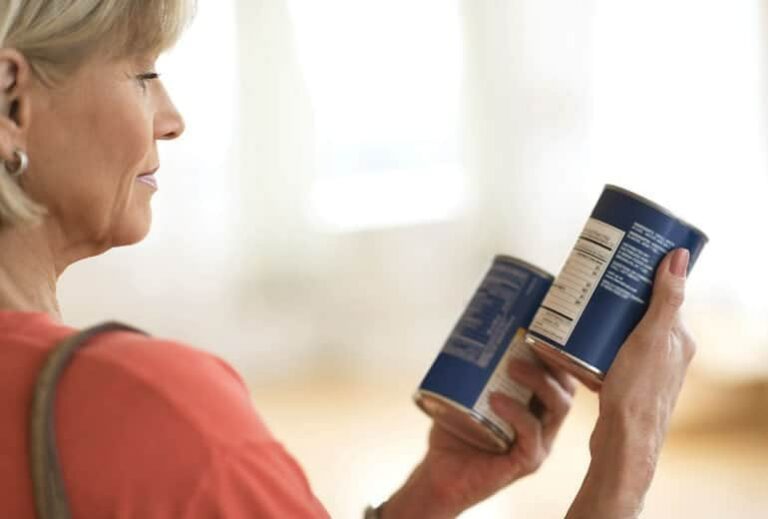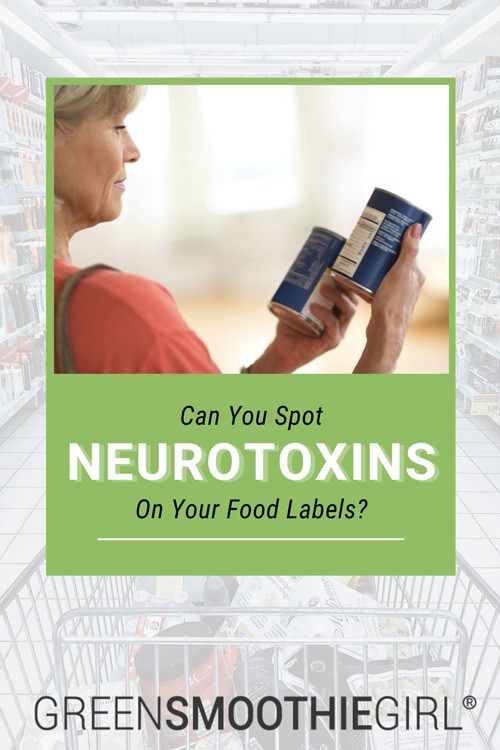Can You Spot Deadly Neurotoxins On Your Food Labels?

Years ago, I was taking my turn running the snack bar at the baseball field during one of my son’s high school games.
It’s not a task I relished, selling poison to children, but it was a requirement of the baseball parents.
A father at the game thought GreenSmoothieGirl selling Snickers bars and soda was a riot. I told him, “If you look at this table, I bet you can’t guess what my pick for WORST snack is.”
Can you guess? These were the options:
- Laffy Taffy
- Snickers
- Hershey’s Chocolate
- 3 Musketeers
- Red Vines
- Roasted Peanuts
- Salted Nut Bar
- Spitz Sunflower Seeds
- Fruit Snacks
He said, “Well, it’s not the peanuts.” True.
It’s the Spitz Sunflower Seeds (Dill or Barbecue flavor). They’re full of MSG, which is a deadly neurotoxin.
[If you want to protect yourself and your family, grab Robyn's Neurotoxin Wallet Card for FREE! Use it when you shop, to protect your health.]
In this article:
- What is MSG
- What do MSG and other neurotoxins do?
- What are other neurotoxins?
- Why are neurotoxins allowed in our food?
- How to avoid neurotoxins in our food
What is MSG?
MSG (monosodium glutamate) is a flavor enhancer–and the worst neurotoxin in our food supply. You can find it in cream-of soups, Doritos, ramen noodles, commercial salad dressings and dressing mixes, and thousands of packaged foods.
I’d take sugar over MSG any day, and you know what I think of sugar. The reason why is related to a painful learning experience in college.
What Do MSG and Other Neurotoxins Do?
In college, I ate Top Ramen and bananas as my staples throughout my sophomore year. Not only were these foods cheap, but I was without a car, and I could carry a bag of these groceries easily.
These are just some of the symptoms I experienced that year that I ate Top Ramen every night for dinner:
- I found myself with terrible vertigo, falling off the sidewalk as I’d walk to school.
- I kept getting viral and bacterial infections.
- I was having chronic, debilitating headaches.
It took the whole year to connect my bizarre and worsening symptoms to the MSG in the Top Ramen seasoning packets.
Neurological symptoms are common in people who eat MSG or other neurotoxins found in the processed food supply. They can have a wide range of effects, depending on what area of the brain they damage and how many brain cells they kill.
Headaches and dizziness like I had are common. Other symptoms of MSG exposure include:
- mood disorders
- sleep issues
- behavioral problems
- cognitive impairment
- reduced motor skills
- seizures
Studies on MSG eaten during pregnancy showed that it crosses the placental barrier. The resulting offspring had neuron death and damages typical of adults eating MSG–damage that affects the ability to learn, remember, balance, and process information coming from other nerves in the body.1, 2
What Are Other Neurotoxins?
In addition to MSG, there are a lot of different neurotoxins in our food supply, usually used as flavorings or preservatives. These include:
- nitrites and nitrates in cured meats
- artificial sweeteners, like sucralose, aspartame, and saccharin
- Bisphenol A (BPA) in plastic containers and lining the insides of canned goods.
Research surrounding all three of these neurotoxins shows how damaging they can be to our health. For example:
- When pregnant women are exposed to nitrites, research shows they have an increased risk for complications like anemia, preeclampsia, and premature labor.3 Research also shows that exposure to high levels of nitrates can cause angina-type pain, heart attack, or cardiovascular death.4
- One study found that consuming high levels of the artificial sweetener aspartame might cause lymphoma and leukemia in rats.5 A similar study found mice who were fed sucralose had increased rates of blood cell tumors.6
- Scientists have determined exposure to Bisphenol A can cause health problems, like breast and prostate cancer, metabolic disorders, precocious puberty, and infertility.7
Why Are Neurotoxins Allowed in our Food?
The FDA has approved and continues to allow MSG on the market. It can now be called by several other names to hide it in food labeling.
The FDA also approved aspartame and refuses to remove its endorsement, despite hundreds of thousands of health-related complaints.
Since the FDA clearly will approve chemical additives that have been proven to be dangerous, it’s up to you and me to take charge of our own health and to be educated about where the dangers lie and how to avoid them.
How To Avoid Neurotoxins in Food
I’ve written before about environmental neurotoxins and how they can be tough to avoid. However, we have control over whether we ingest neurotoxic food additives. We just need to be vigilant.
Most processed foods have at least one of these neurotoxins. When you’re reviewing food labels, remember that many manufacturers try to disguise these ingredients by using different names. For that reason, look for all the alternative names listed here.
1. Monosodium Glutamate (MSG): known to cause headache, flushing, numbness, rapid heartbeat, nausea, and sweating in some people; found in most processed foods. Check labels for any of these alternative names:
- Monopotassium Glutamate
- Glutamic Acid
- Maltodextrine
- Autolyzed Yeast
- Yeast Extract
- Anything labeled “Hydrolized”
- Calcium Caseinate
- Sodium Caseinate
- Texturized Protein
- Whey Protein
- Corn Starch
- Corn Syrup
2. Nitrites: known to cause mild dizziness, lethargy, convulsions, or coma; found most often in cured or smoked meats. Check labels for any of these alternative names:
- Sodium Nitrite
- Sodium Nitrate
3. Artificial Sweeteners: known to cause headaches, migraines, dizziness, anxiety, depression, and weight gain. Found in “sugar-free” or “diet” products. Check labels for any of these alternative names:
- Sucralose (Splenda)
- Saccharine (Sweet n Low)
- Aspartame (Nutrasweet, Equal)
Avoiding neurotoxins in food is a challenging task—but one that’s extremely worthwhile when it comes to protecting your health and your family.
To make it a little easier, I’ve compiled this information for you on a printable wallet card. Get it here and share it with the people you love.
Next: For even more health shortcuts and cheat sheets, check out the Genius Guides! You’ll get this wallet card, along with 9 other cards — all printed and laminated for you — so you can make healthier food choices, avoid dangerous ingredients, and keep your family safe.

Resources:
1. Gao J, Wu J, Zhao XN, Zhang WN, Zhang YY, Zhang ZX. “Transplacental neurotoxic effects of monosodium glutamate on structures and functions of specific brain areas of filial mice.” Acta Physiological Sinica. 1994. 46 pp 44-51
2. Gill S, Barker M, Pulido O. “Neuroexcitatory Targets in the Female Reproductive System of the Nonhuman Primate.” Toxicologic Pathology. 2008. 36(3) pp 478-484
3, 4. Agency for Toxic Substances and Disease Registry “What Are the Health Effects from Exposure to Nitrates and Nitrites? December 2013.” Retrieved from: https://archive.cdc.gov/#/details?q=r.cdc.gov/csem/nitrate-nitrite/health_effects.html&start=0&rows=10&url=https://www.atsdr.cdc.gov/csem/nitrate-nitrite/health_effects.html
5. Soffritti M, Belpoggi F, Esposti DD, Lambertini L. Aspartame induces lymphomas and leukaemias in rats. European Journal of Oncology 2005; 10(2):107–116.
6. Soffritti M, Padovani M, Tibaldi E, et al. Sucralose administered in feed, beginning prenatally through lifespan, induces hematopoetic neoplasias in male Swiss mice. International Journal of Occupational and Environmental Health 2016; 22(1):7–17.
7. Konieczna A, Rutkowska A, Rachoń D. “Health risk of exposure to Bisphenol A (BPA)” Rocz Panstw Zakl Hig. 2015;66(1):5-11. https://www.ncbi.nlm.nih.gov/pubmed/25813067

Disclosure: This post may contain affiliate links that help support the GSG mission without costing you extra. I recommend only companies and products that I use myself.
Posted in: Detox, Mind/Body Connection, Preventive Care, Relationships, Whole Food















